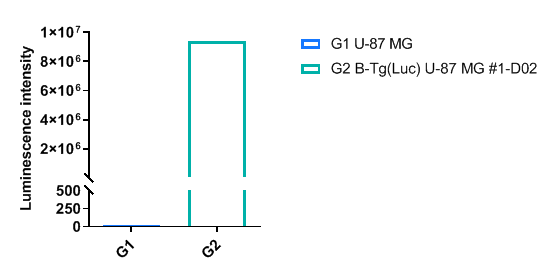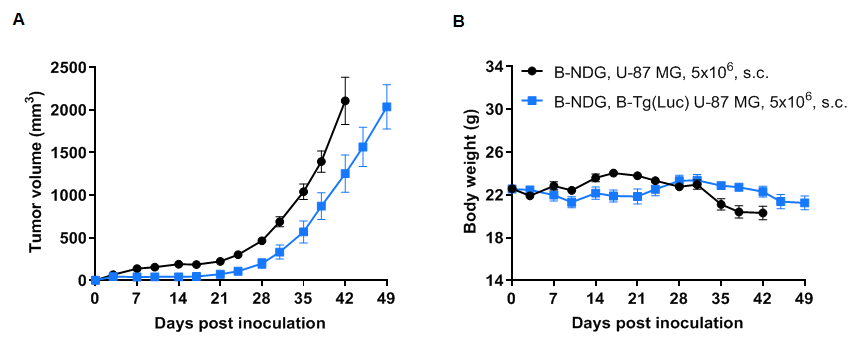B-Tg(Luc) U-87 MG
|
Common name |
B-Tg(Luc) U-87 MG |
Catalog number | 322265 |
| Aliases |
NA |
Disease | Glioblastoma |
|
Organism |
Human | Strain | NA |
| Tissue types |
Brain |
Tissue | Brain |
- Origin: The U-87 MG cell line is derived from malignant gliomas of a male patient who likely had Glioblastoma. The cell line is commonly used in neuroscience and immuno-oncology research.
- Background Information: The Luciferase reporter gene system is a reporting mechanism that employs luciferin as a substrate to detect the activity of firefly luciferase. The luciferase enzyme can catalyze the oxidation of luciferin into oxyluciferin, and during this process, bioluminescence is emitted. It's currently the most commonly used luciferase in both in vivo and in vitro detection experiments. By introducing Luciferase fluorescent markers into tumor cells, it can be used to construct various types of subcutaneous, in situ or metastatic tumor models and enables real-time monitoring of the biological behavior of marked tumor cells in vivo.
- Gene targeting strategy: The exogenous promoter and luciferase coding sequence were randomly inserted into the U-87 MG cells.
- Tumorigenicity: Confirmed in B-NDG mice.
- Application: The B-Tg(Luc) U-87 MG cell line stably expresses luciferase, and can be used to evaluate drugs by monitoring the activity of anti-glioblastoma antibodies in xenograft animal models through in vivo bioluminescence imaging.
In vitro luciferase activity of B-Tg(Luc) U-87 MG cells

Luminescence signal intensity of B-Tg(Luc) U-87 MG cells. Single cell suspensions from wild-type U-87 MG and B-Tg(Luc) U-87 MG #1-D02 cultures were measured using the Bright-GloTM luciferase Assay (Promega, Catalog No. E4030). B-Tg(Luc) U-87 MG cells have a strong luminescence signal that is not present in wild-type U-87 MG cells.

Subcutaneous tumor growth of B-Tg(Luc) U-87 MG cells. B-Tg(Luc) U-87 MG cells (5x106) and wild-type U-87 MG cells (5x106) were subcutaneously implanted into B-NDG mice (female, 7-9-week-old, n=6). Tumor volume and body weight were measured twice a week. (A) Average tumor volume. (B) Body weight. Volume was expressed in mm3 using the formula: V=0.5 X long diameter X short diameter2. Results indicate that B-Tg(Luc) U-87 MG cells were able to establish tumors in vivo and can be used for efficacy studies. Values are expressed as mean ± SEM.

Growth kinetics of B-Tg(Luc) U-87 MG tumors determined by bioluminescence imaging (BLI) . B-Tg(Luc) U-87 MG cells (5x106) were subcutaneously implanted into B-NDG mice (female, 7-9-week-old, n=6). Signal intensity and body weight were measured twice a week. (A) Signal intensity. (B) Raw bioluminescence images. These results indicate that B-Tg(Luc) U-87 MG cells can be used for in vivo efficacy evaluation. Values are expressed as mean ± SEM.

Growth kinetics of B-Tg(Luc) U-87 MG tumors determined by bioluminescence imaging (BLI) . B-Tg(Luc) U-87 MG cells (1x105, 2x105) were injected into the brain of wild-type B-NDG mice (female, 8-week-old, G1 n=5, G2 n=6). Signal intensity and body weight were measured twice a week. (A) Signal intensity. (B) Body weight. (C) Raw bioluminescence images. These results indicate that B-Tg(Luc) U-87 MG cells can be used for in vivo efficacy evaluation in brain orthotopic tumor models. Values are expressed as mean ± SEM.








